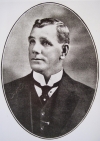Born: Established: ca. 30 Dec 1867 Edinburgh,
AustLit

Born: Established: ca. 30 Dec 1867 Edinburgh,
BiographyHistory
Most Referenced Works
Notes
-
1. ANDY KERR'S PUBLICITY:
The following list comprises quotations relating to Andy Kerr that were published in various newspapers and magazines. A number were, however, reproduced within Australian Variety.
- 'His long odds prices up to as much as 2000 to 1 on a straight-out pony event makes the Grabbing Tote blush' (Mudgee Guardian - qtd in Australian Variety 31 March 1915, p.2).
- 'The [Melbourne] bookmaking fraternity was reinforced by a strong contingent from Sydney, one of whom (the Coogee Bunyip) quite eclipsed the local talent by laying odds against outsiders, reminiscent of record prices in the Totaliser. He had a small army of clerks and bag holders, the layer's bodyguard' (Age - qtd. in Australian Variety 31 March 1915, p.2).
- 'When a heavy dividend is paid out on the Tote, it is well reported, and much made of the fact. It is thus only fair to tell of a heavy stake being won at the outlay of a few pounds from a bookmaker, which happened on Wednesday at Rosebery races. When Playtile won the second division of the Rosebery handicap, very few laid anything against him. However, one of the layers (Kerr of Coogee) is noted for long odds, and backers go to him. In this case he laid about 500 to 5 against the winner, of which 200 to 2 went to the stable, and the other 300 was distributed among small punters' (Evening News - qtd. in Australian Variety 31 March 1915, p.2).
- 'Jack Cannot in the [Tivoli] Follies hands Isabelle D'Armond a £150 diamond ring. She threatens to keep it. "I will tell you," says Mr Cannot going down on his knees and tearfully pleading for the return of it, "a little story. It might touch your heart. That ring is not mine. It is Andy Kerr's. So do, oh do give it back." Needless to say it is good for a great laugh for a variety of reasons' (Theatre Magazine July 1915, p.35).
- 'The only man in the world who lays and pays £1,000 to £1 straight-out on day race' (Sportsman - qtd in Australian Variety 8 September 1915, p.16]
- 'He writes tickets and handles money faster than any man seen in Victoria. The clients round his ring were often ten deep' (Judge - qtd in Australian Variety 12 April 1916, n. pag).
- 'The man from Coogee did an enormous business. He told the punters that any money he misses throwing into his men's bags they could have. Needless to say, he missed nothing' (Table Talk - qtd in Australian Variety 12 April 1916, n. pag].
- 'The Sydney Bookmaker, Andy Kerr, was the centre of attraction in the Paddock at Flemington [Melbourne] on Saturday on account of the way he bet. He did a roaring business, and it was impossible to get near him. Sight-seers obstructed those who wished to speculate. He laid 1000 to 4 against St Bees, who ran second in the maiden Plate, 1000 to 10 Grand Marshal, who ran third, and in the Derby 100 to 1 the four outsiders. he is the talk of the town' (The Sun - qtd in Australian Variety 12 April 1916, n. pag).
- 'The Tote cannot give the "Bunyip" any start; his long odds stands alone without rival' (Recorder - qtd in Australian Variety 12 April 1916, n. pag).
- 'The Coogee Bunyip says he has a solid cash guarantee of £25,000, and if that runs dry he can fall back on the Bunyip's village' (E. S. Advocate - qtd in Australian Variety 12 April 1916, n. pag).
-
The quotations and verse below were included in Kerr's own advertising:
- 'You know your old pal ANDY KERR / At Melbourne he's sure to be there / If your down for the Cup / You must look Andy up / For his long odds will make you all stare! (Australian Variety 28 October 1914, p.16).
-
2. HISTORICAL NOTES AND CORRECTIONS:
2.1. Australian Variety's front covers record that the magazine was being 'conducted by Andy Kerr and Martin C. Brennan,' with inside publications details indicating that Kerr's position was as manager, while Brennan acted as editor. Fine print details on each cover further record 'Printed and published by Andy Kerr and Martin C. Brennan at 228 and 250 Pitt Street, Sydney, New South Wales' (ctd. 13 May 1920).
2.2. The reference to Andy Kerr's ring by Jack Cannot (see above note field) relates to an incident in June 1915 when Kerr allegedly lost possession of a £550 diamond ring (ctd. Theatre Magazine July 1915, p.51).
-
FURTHER REFERENCE:
The following list comprises articles, pars, and reports relating to Andy Kerr that are not given individual entries in this database.
Entries with an asterisk (*) beside them indicate that the source is an advertisement.
- Australian Variety: 28 October 1914, p.16* / 31 March 1915, p.2* / 8 September 1915, p.16* / 12 April 1916, n. pag.* / 4 April 1917, p.3 [re: Kerr's association with Australian Variety] / 21 December 1917, n. pag. / 1 January 1920, p.15 /
- Green Room: October 1919, p.18 [re: H.M.S. Pinafore season at the Boomerang Theatre].
-
Entries connected with this record have been sourced from on-going historical research into Australian-written music theatre and film being conducted by Dr Clay Djubal.
Additional information has been sourced from John Ritchie's entry on Andy Kerr in the Australian Dictionary of Biography Vol 9 (1983), pp.574-575 (q.v.).

